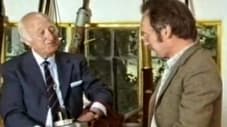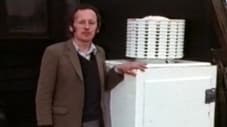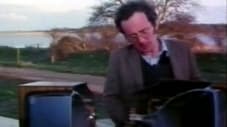Season 1 (1988)
← Back to season list
Episodes 6
The Secret Life of the Vacuum Cleaner
Before the invention of the vacuum cleaner, carpets and upholstery were taken outside and beaten once a year to get the dust out (the 'Spring' clean). Fitted carpets were totally impractical.
Episode Contents:
Models: Three different kinds (cylinder, upright, hybrid) of cut away vacuums. Homemade solenoid. Plastic bag car jack.
Machines: Tim's automated hair raising, eye rolling portrait. Tim's "Common Ground" collecting box which simulates different footprints using a vacuum and a sheet of rubber.
Guests: An array of ineffective hand powered vaccuums.
Films: Singin hoover ad from the 30's.
Extro: Flying vacuums!
Read MoreThe Secret Life of the Washing Machine
The earliest form of automatic washing was the nautical practice of towing clothes behind the ship. The combination of agitation and a constant flow of clean water washes the clothes quite effectively.
Episode Contents:
Models: Solenoid valves and pressure switches explained. Various cut away washing machines and their ingredients: weighted base, heating element, pumps, timer.
Machines: A thunder simulator by Tim. A stunt by Rex using a solenoid cannon to roll a car. One of the best of Tim's collecting boxes, the Chiropodist who nods, twiddles her thumbs and then dissapears and tickles your foot (automatic british mickey taking at it's best).
Guests: Again, lots of antique specimins (including the canadian shocker!). Industrial washing machines and the way they deal with the eccentricities of a load of water.
Extro: A mountain of washing machines.
Read MoreThe Secret Life of the Sewing Machine
The first patent for a sewing machine was taken out by an English cabinetmaker called Thomas Saint in 1790. It's doubtful whether he actually built his design, because, when one was made from his drawings 100 years later, it had to be extensively modified to work.
Episode Contents:
Models: A giant human powered lock stitcher demonstrates the basic idea. A cut away singer shows how a crank powers all the basic functions. A demonstration of cams and stepper motors.
Machines: Three of Tim's famous collecting boxes: The head scratching curator the rubber-necked guard and the doctor that writes out illegible prescriptions. There are some brief close ups of the construction of these machines. Rex also shows his magical remote controlled suitcase.
Guests: A thumb crushing Thimmonier (the 1st practical sewing machine) Many antique decorative sewing machines.
Films: The old Singer advert from the 40's is probably the funniest clip in this series.
Extro: Say it in thread.
Read MoreThe Secret Life of the Refrigerator
Commercial refrigeration equipment was first developed in Australia, where the winters weren't cold enough to produce much natural ice. A brewery was the first company to commission an artificial ice making plant (in 1865) so cooling Australian lager was the first use of artificial refrigeration.
Episode Contents:
Models: Disassembling a compressor. Demonstration of thermostat Machines: Rex's homemade air rifle. Tim's elaborate wall mounted water clock.
Guests: Early ice box. A turn of the century ammonia refrigerent ice factory. Various early fridges.
Archival: GE film from 1935 starring Bette Davis. Hilarious old promo from 1957 with a woman hugging her fridge! Goofy commercial involving an elephant and an old style fridge.
Extro: Stop motion fridges.
Read MoreThe Secret Life of the Central Heating System
At first Roman houses simply had a fire in the middle of the room (the Latin for hearth is focus). But they probably had trouble with smoke as the Latin for living room is atrium (from ater meaning black). By about 400AD the Romans had perfected a form of central heating. The fire was lit outside in a furnace with hot air ducts under the floors and in the walls.
Episode Contents:
Models: Trying to start a fire with an electric drill. A Norman chimney vs a proper one. A life size 2 dimensional house model with radiators and boiler. A glass radiator. A balanced flue.
Machines: Jacob's ladders by Rex.
Guests: Solid fuel, oil and natural gas boilers.
Films: Yet another silly 40's promotional film, this one for the Ascot gas boiler.
Extro: The model house springs a leak.
Read MoreThe Secret Life of the Television Set
John Logie Baird, the Scottish inventor, developed an electromechanical TV system in the 1920s and gave frequent public demonstrations. The publicity encouraged EMI to develop a practical all-electronic system, similar to today's. In 1936 the BBC transmitted both systems, but EMI's was judged superior.
Episode Contents:
Models: TV scanning is demonstrated with a drawing made on many strands of string. A cutaway TV and cards that mimic the screening of a colour TV. Explanation of the simplest electronic components.
Machines: Tim's displays at the National Film and Television Museum (UK)
Guests: British TV sets from before and after WWII.
Films: Zworykin interview. J.L. Baird cartoon.
Extro: A mountain of live televisions set on fire.
Read More





